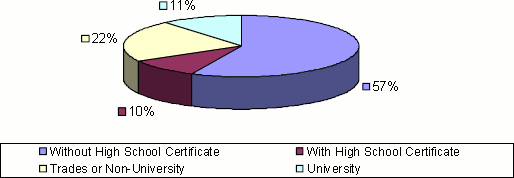The Social & Economic Landscape
Bridging the Gap: From Education to Employment, Pilot Phase II
Bridging the Gap: From Education to Employment, Pilot Phase II
Educated People
This section presents a description of the area with regard to its educational characteristics. This includes looking at levels of formal education such as high school, college and university, as well as touching on issues such as literacy and skills training. It is also concerned with how these issues intersect with gender and employment characteristics.
Level of Education—Total population
Comparing the three graphs below, we can see the Triton area has a greater number of people with a high school education than both the Economic Zone and the Province, but also a significant percentage of people without a high school education — more than 20% when compared to the province. There is also a substantial gap at the trades/nonuniversity level, where Triton has 9% and 15% deficits when compared to the Economic Zone and the Province respectively. Unfortunately, university data is not available at the community level.
Level of Education - Economic Zone 11

